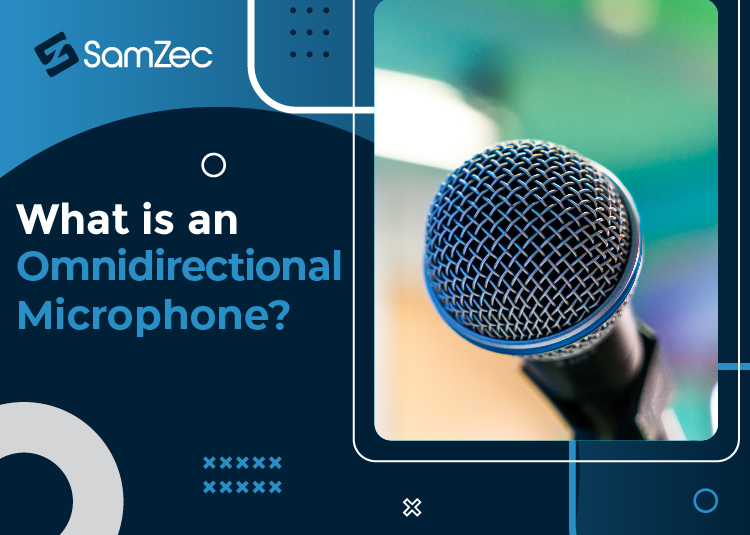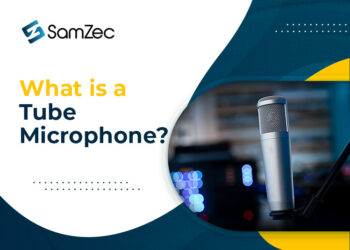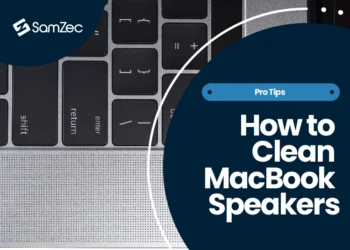An omnidirectional microphone is a type of mic which picks up sound from all directions, making it a great option for professionals, amateurs, and students alike. In addition, these microphones are compact and durable, making them a great portable choice.
Omnidirectional mics can be used for voice recording and instrument recording and also often come with additional features such as an on/off switch or volume control.
How does an omnidirectional microphone work?
The omnidirectional microphone detects the air pressure variations around it and converts them into readable analog data. These are then inverted to digital form by the built-in ADC, and then the data is interpreted by the electronics inside the microphone. The microphone is built with a very thin membrane that is flexible, and this membrane is used to detect changes in pressure.
The membrane has a hole at the center for the sound waves to pass through to the diaphragm; this diaphragm is very thin and light; it vibrates from the pressure of the sound waves, and the varying air pressure at the hole is detected by the electronics and data is interpreted from it.
The small, compact and robust design makes the omnidirectional microphone a popular choice in many applications like fitness monitoring systems and sound recognition systems.
Read more: How To Connect A Microphone To A Bluetooth Speaker
Why do you need an omnidirectional microphone?
The omnidirectional microphone is a particular type that can pick up sounds from any direction with about the same sensitivity. It is essential, for example, in certain situations where you have multiple sources of sound, and you don’t want your recording to include any other sounds but those of the desired reference.
For example, if you are recording a conference, you might want to make sure that the microphones of all the people attending pick up their voices, but not the sounds of other people in the room.
Benefits of the omnidirectional microphone
The omnidirectional microphone (Omni) is a microphone from which sound is picked up in all directions, unlike cardioid or bi-directional microphones, which pick up sound from one direction only. They are perfect for conferences and meetings, lecture halls and classrooms, and especially for houses of worship.
There is no unique technique involved in using an omnidirectional microphone other than being aware of the proximity effect, which will make it sound as if the speaker is shouting. This proximity effect can be compensated by adjusting the amplifier gain or the EQ level. Since there is no “one-direction” pick-up pattern, these microphones can be used in noisy surroundings without becoming overloaded, as happens with other directional microphones.
Conclusion:
An omnidirectional microphone is a microphone that picks up audio from all directions. It is opposed to a directional microphone, which only picks up audio from a limited and specific direction.
Omnidirectional microphones are often used in security cameras, as an omnidirectional mic can pick up audio from a much larger area than a directional one. Omnidirectional microphones are also used in things like bird and frog recorders.
FAQs
What are omnidirectional mics good for?
Omnidirectional mics are suitable for recording in tight situations and picking up sounds far away. Rode NTG3 is an excellent example of an omnidirectional microphone used in familiar cases when you do not have enough room for the boom. However, even if you have enough room for a boom, this mic is great for getting a singer’s vocals in a band or in a room where loud instruments are playing.
How do I know if my mic is omnidirectional?
The microphone is omnidirectional if it has a donut shaped pattern. This type of microphone is used for recording interviews and spoken material.
Do omnidirectional microphones make good boom mics?
Yes, omnidirectional microphones make good boom mics. It is the most common microphone used in radio and TV programs. An omnidirectional microphone has a wide range of recording range. It can record sound from all directions at the same time. Most radio and TV stations use this kind of microphone to record every session or activity carried out. It is like multiple microphones with a single set. An omnidirectional microphone is usually preferred for its quality and effectiveness.
What is a rifle microphone?
A rifle microphone is a device for recording sound, especially dialogue, on film sets, television studios, and other productions. It is also called a boom or boom pole. A boom microphone is mounted on a stickhandled by someone called a boom operator or boom mic operator.




















